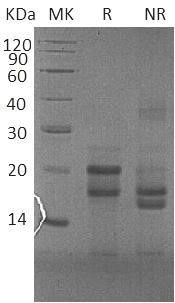Recombinant Human Cathepsin S/CTSS (C-6His)
Shipping Info:
For estimated delivery dates, please contact us at [email protected]
| Amount : | 50 µg |
| Content : | Supplied as a 0.2 µm filtered solution of 20mM MES, 150mM NaCl, 10% Glycerol, pH 5.5. |
| AA sequence : | Recombinant Human Cathepsin S is produced by our Mammalian expression system and the target gene encoding Gln17-Ile331 is expressed with a 6His tag at the C-terminus. |
| Alternative Name : | Cathepsin S, CTSS |
Source : Human Cells;
Cathepsin S is a lysosomal enzyme that belongs to the papain family of cysteine proteases. This protein is expressed by antigen presenting cells including macrophages, B-lymphocytes, dendritic cells and microglia. Moreover, cathepsin S is expressed in some epithelial cells. Compared with the abundant cathepsins B, L and H, cathepsin S shows a restricted tissue distribution, with highest levels in spleen, heart, and lung. In addition, evidences indicated that cathepsin S generates A beta from amyloidogenic fragments of beta APP in the endosomal/lysosomal compartment, and is implicated in the pathogenesis of AlzheimerÂ’s disease (AD) and Down Syndrome (DS).
Cathepsin S is a lysosomal enzyme that belongs to the papain family of cysteine proteases. This protein is expressed by antigen presenting cells including macrophages, B-lymphocytes, dendritic cells and microglia. Moreover, cathepsin S is expressed in some epithelial cells. Compared with the abundant cathepsins B, L and H, cathepsin S shows a restricted tissue distribution, with highest levels in spleen, heart, and lung. In addition, evidences indicated that cathepsin S generates A beta from amyloidogenic fragments of beta APP in the endosomal/lysosomal compartment, and is implicated in the pathogenesis of AlzheimerÂ’s disease (AD) and Down Syndrome (DS).
|
There are currently no product reviews
|
















.png)








